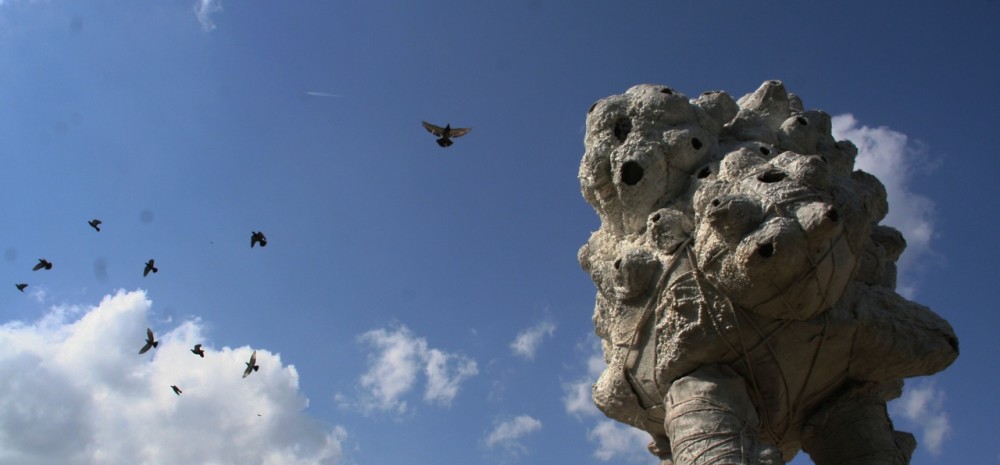Migration is a ‘nonument’ for a home threatened, yet resilient in the face of displacement and climate change. Migration brings to light marginalized communities in the urban ecosystem of Washington DC. Symbolically, these nests are much like neighborhoods now on the move, embracing, adapting, or resisting forces of gentrification sweeping the city. Practically, each piece provides respite along the Atlantic Flyway for birds, more than half of which are changing their nest sites and migratory patterns on an unprecedented scale to adapt to habitat loss as a result of warming temperatures. At the same time, many urban residents may be asked to leave their homes as a result of un-inclusive urban redevelopment strategies.
 My experience with Southwest DC really began while installing Migration for Nonuments.  While my work was often warmly received, comments like “I love art as habitat for bird life, but do any of them shelter people?†really resonated.  I wanted to say YES of course, as it was originally part of my plan. But ironically, the legal and political challenges of access ‘public’ art shares with ‘public’ housing are many.  The forms and scale of Migration also reminded others of an alien invasion. While initially a humorous allusion to science fiction, it poignantly suggests a feeling some residents share that their neighborhood is being colonized by forces beyond their control.  Communities would like to see their neighborhoods improve, as long as existing residents are allowed to participate in the decision-making process.
 Many relationships between my piece and other artists’ work became apparent in Nonuments. We all approached social and environmental justice with overlaps in the politics of consumption, production, labor, equity, and the poetics of our materials. During my research, it became apparent the issue of gentrification in cities like Washington D.C. resonates with global trends of displacement too, as migration arises due to vast economic inequities between the rich and poor in developing countries, but now exacerbated by environmental degradation triggered by a changing climate.  The poor are among those most heavily affected by these changes, as they often lack the resources to adapt to increasing regional stresses, forced to move to urban centers, where jobs or safe infrastructure are not in place to accommodate the rising populations. Ironically, as many have enjoyed greater mobility over the last century, human and environmental exploitation has expanded. Such displacement can have positive and negative effects on the coping capacity of different regions. While the gradual deterioration of environmental and economic conditions may cause migration, relieving some areas, and placing others under pressure, in both cases greater care in how we build, connect with each other, and understand our impact on the ecosystems we inhabit are crucial.
Researching bird habitats I realized different conditions were needed to attract swallows like water, tall grass, vast meadows, and abundant insects. However, some pigeons began roosting on sculptures or gathering near their legs. Maybe it is fitting that long time residents like pigeons, proven resourceful in the most adverse urban conditions, could make a home of Migration.  My work is usually created from, and documented amidst forests, fields, and coastlines. Migration drew no strength from such environments, instead depending on the green screen of a stark urban wall to throw form into high relief.
Migration is a subtle rumination on how the planet’s urban centers grow, and ultimately adjust to accommodate their citizens. Can we live in neighborhoods of economic, social, cultural diversity that aren’t determined solely by a market economy? This piece provides a chance for art to enter and enrich the everyday lives of residents walking between home, work, and school.  Where we nest physically, emotionally, psychologically, culturally, and spiritually is an important aspect of our identity. Swallows build cities like humans. Watching the murmurations of swallows in the sky, as their streams morph into vast clouds, rising and falling, finally dissipating only to reform with great intensity, it is easy to imagine how urban communities may collectively reshape their destinies. Ultimately, Migration may be moved to a suitable regional park or arboretum to become habitat for nesting birds in the spring. But perhaps Migration will linger in the minds of those in Washington D.C. who dream of a city where there is a place for everyone.
Â
